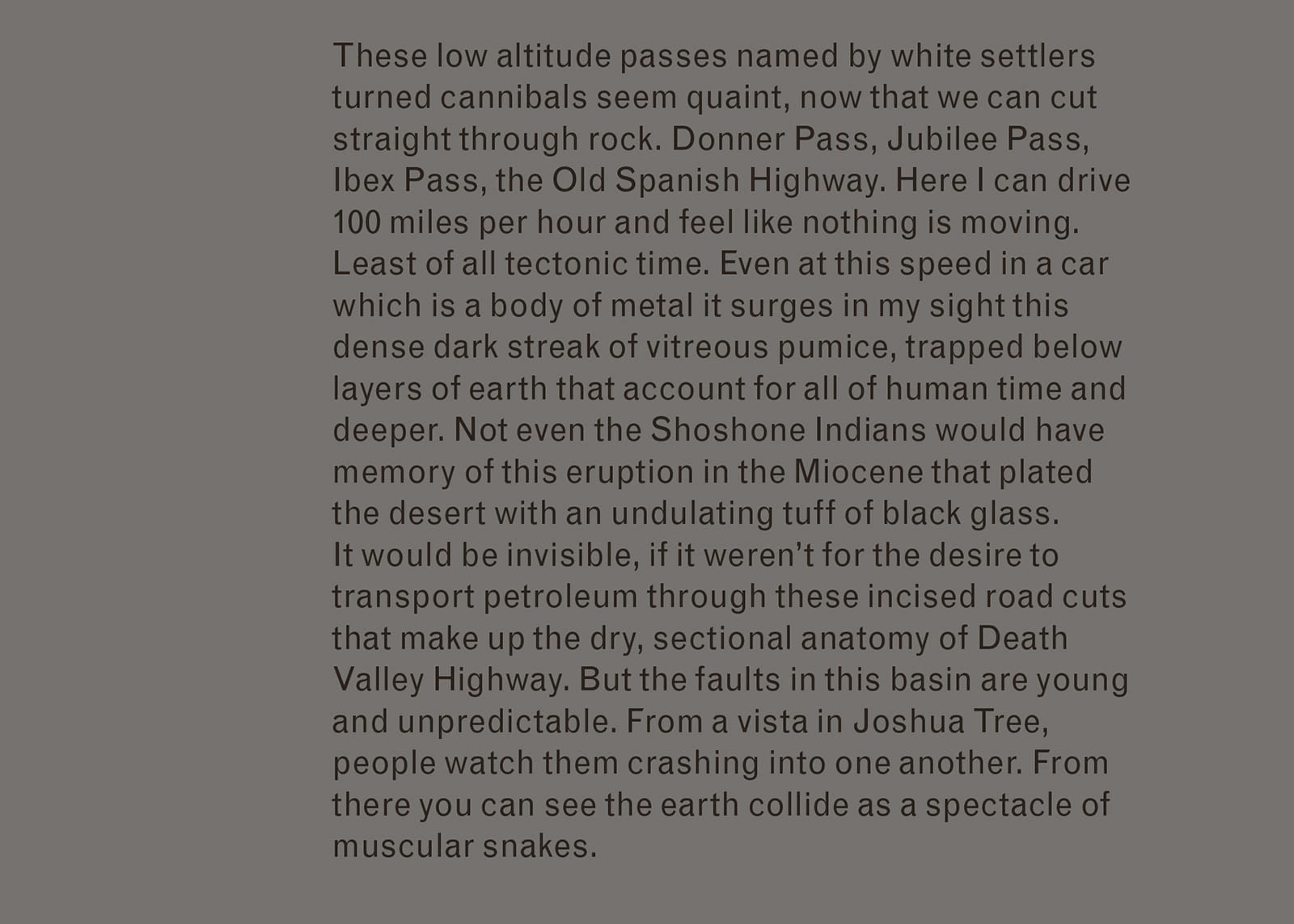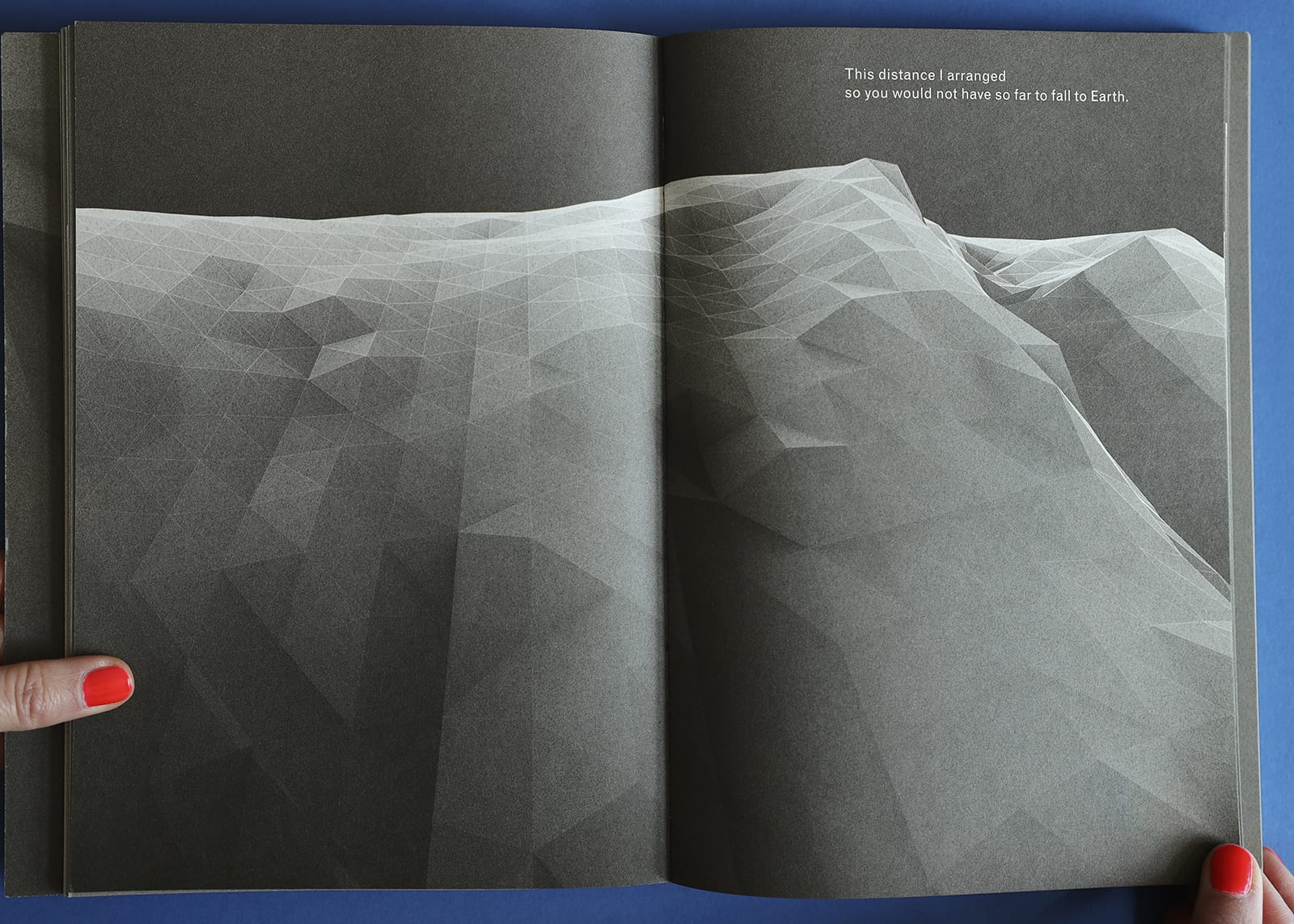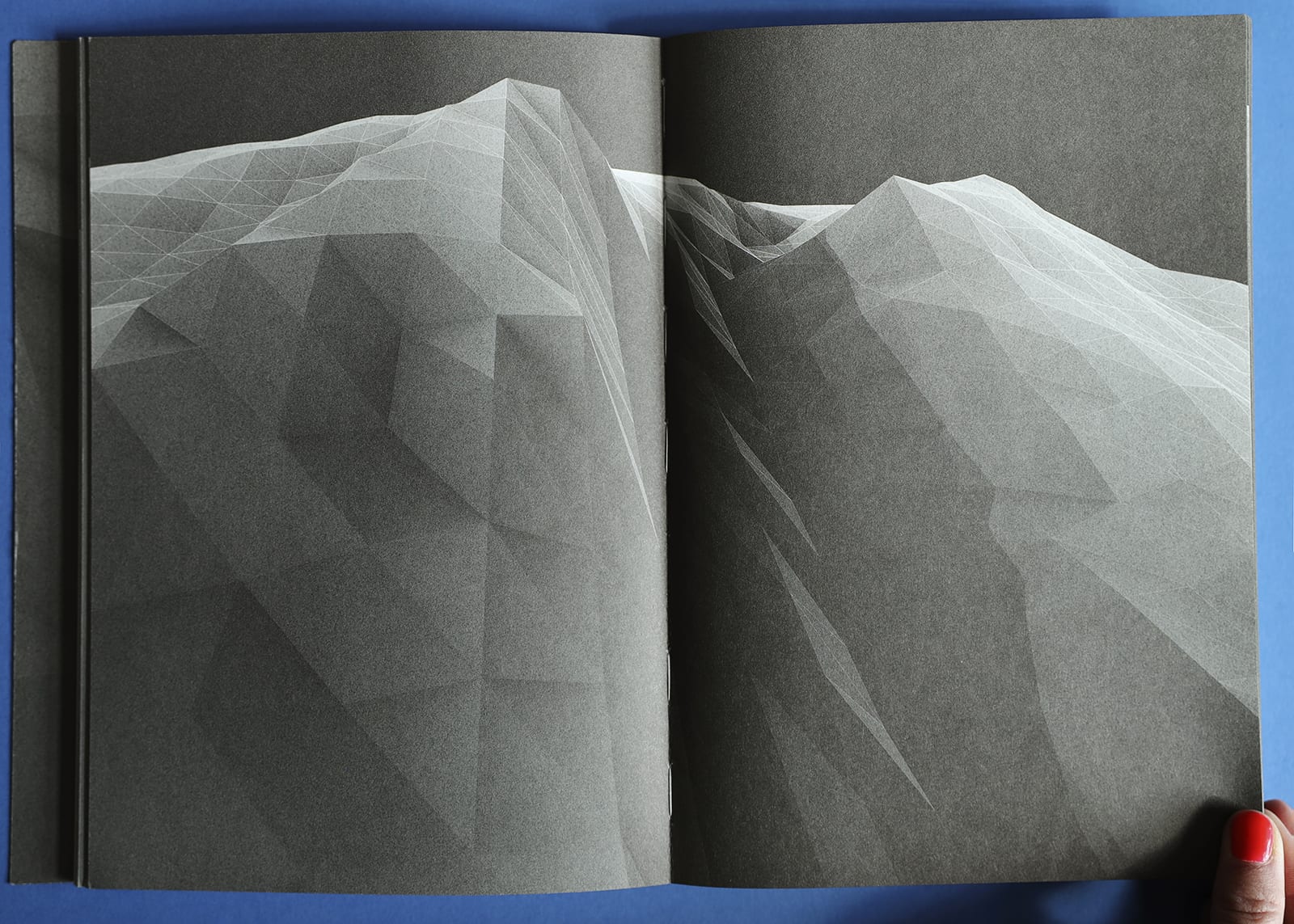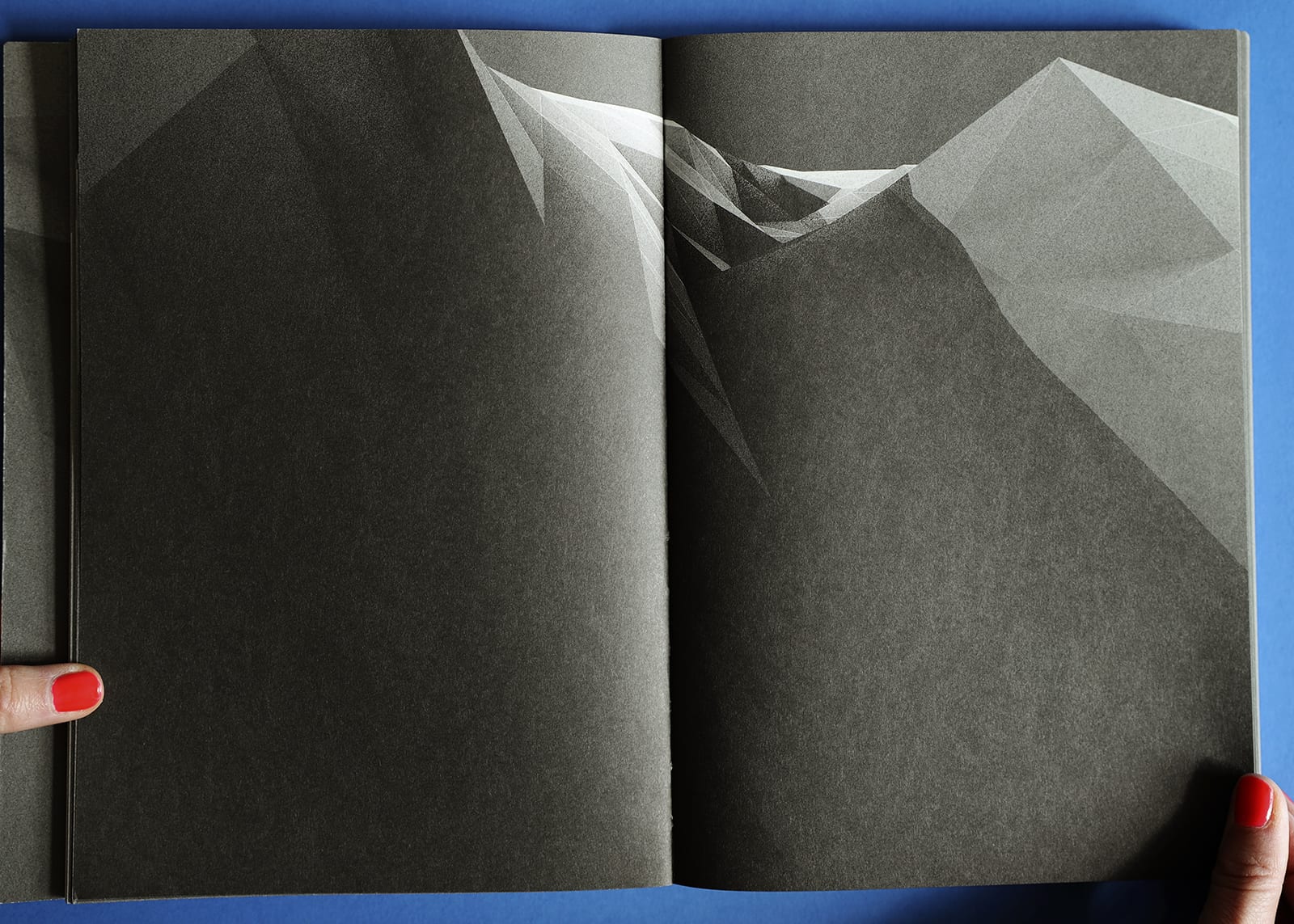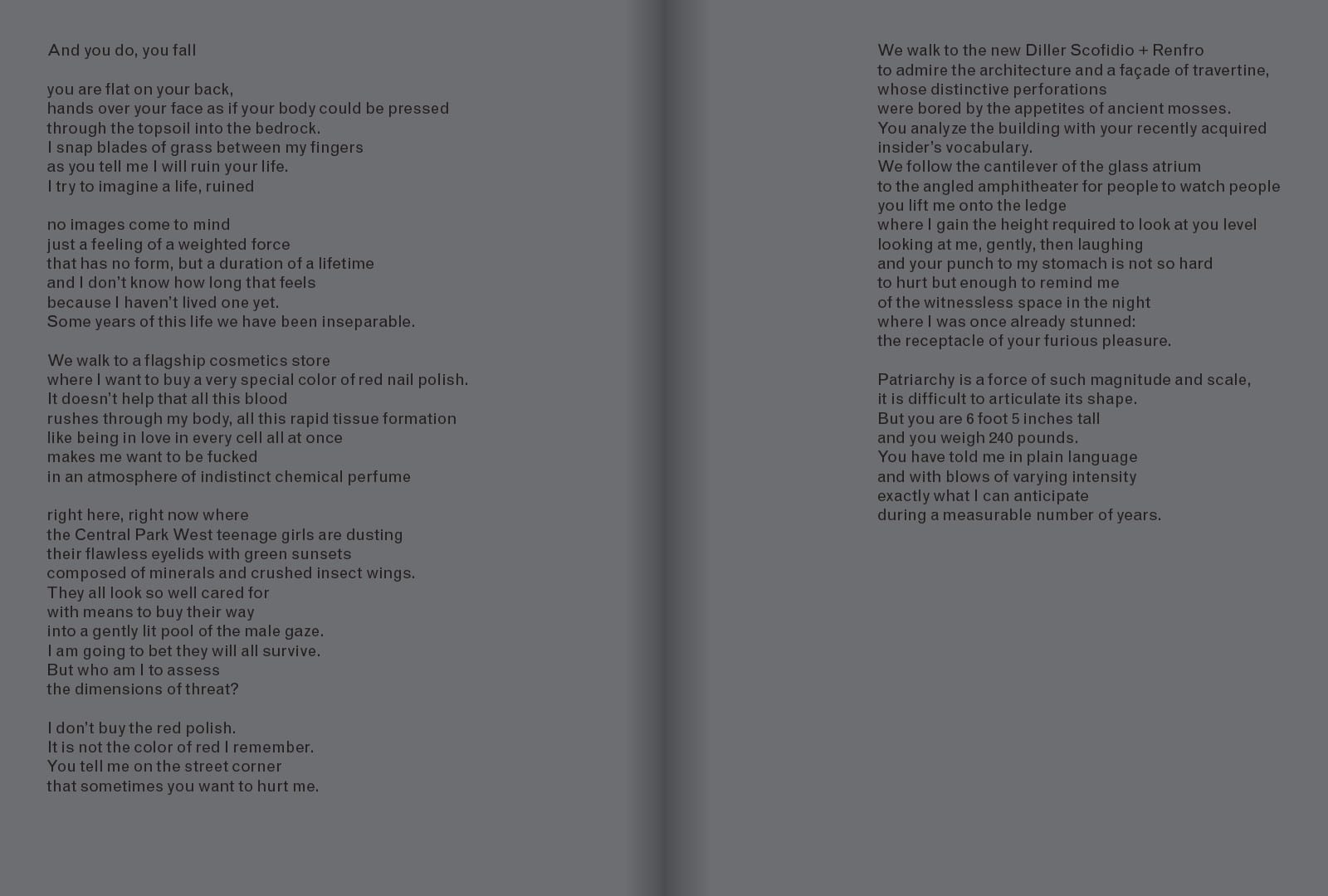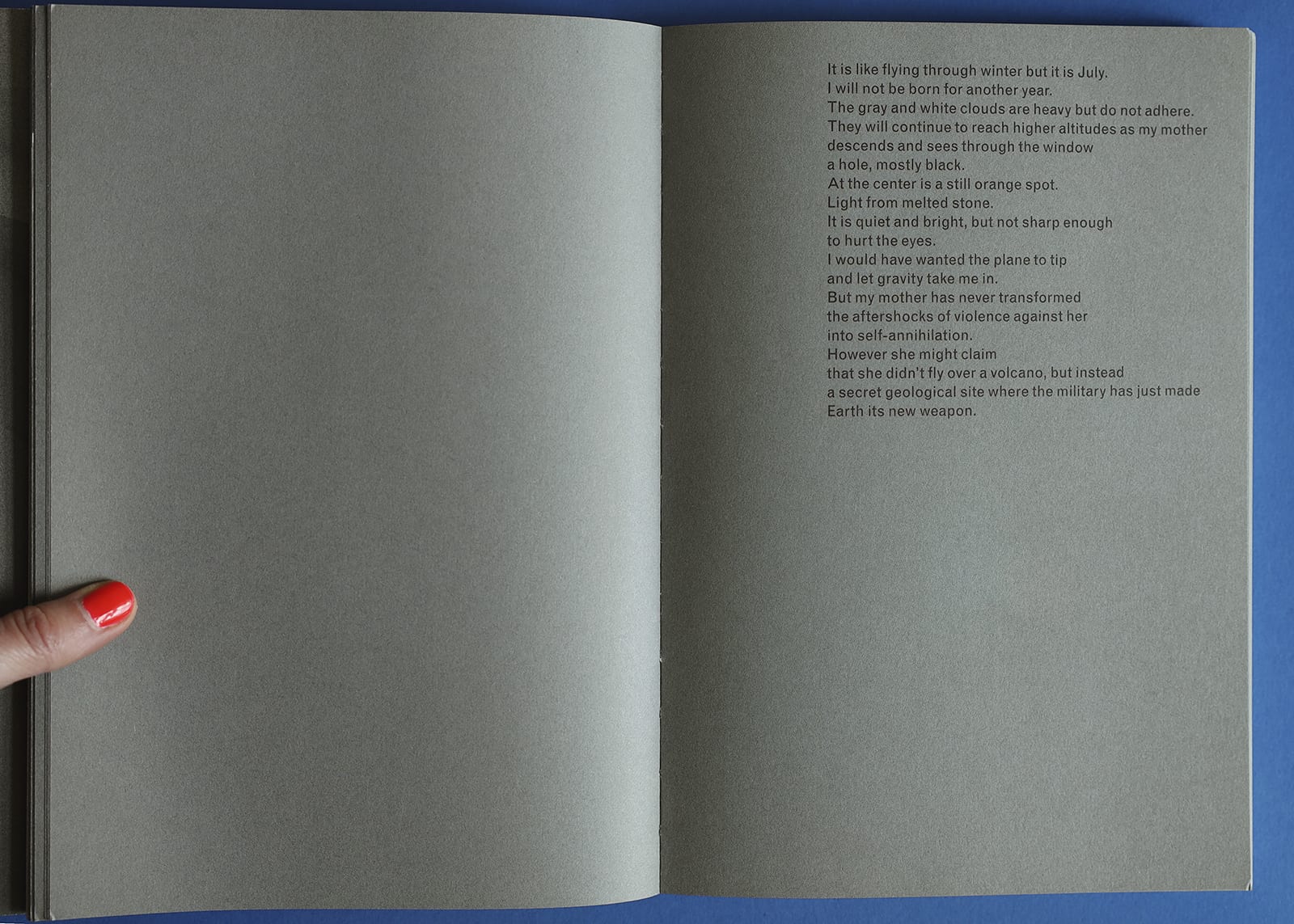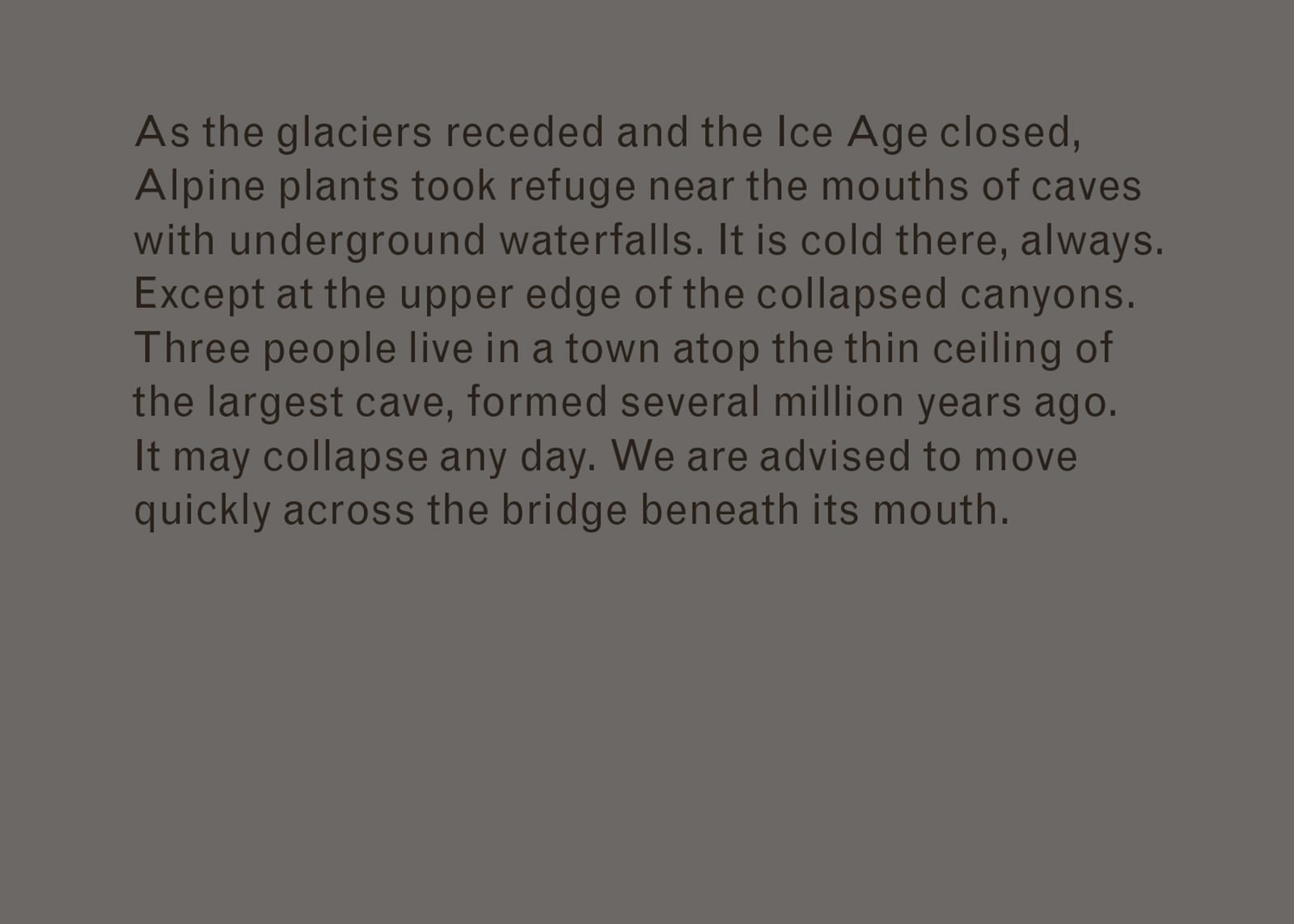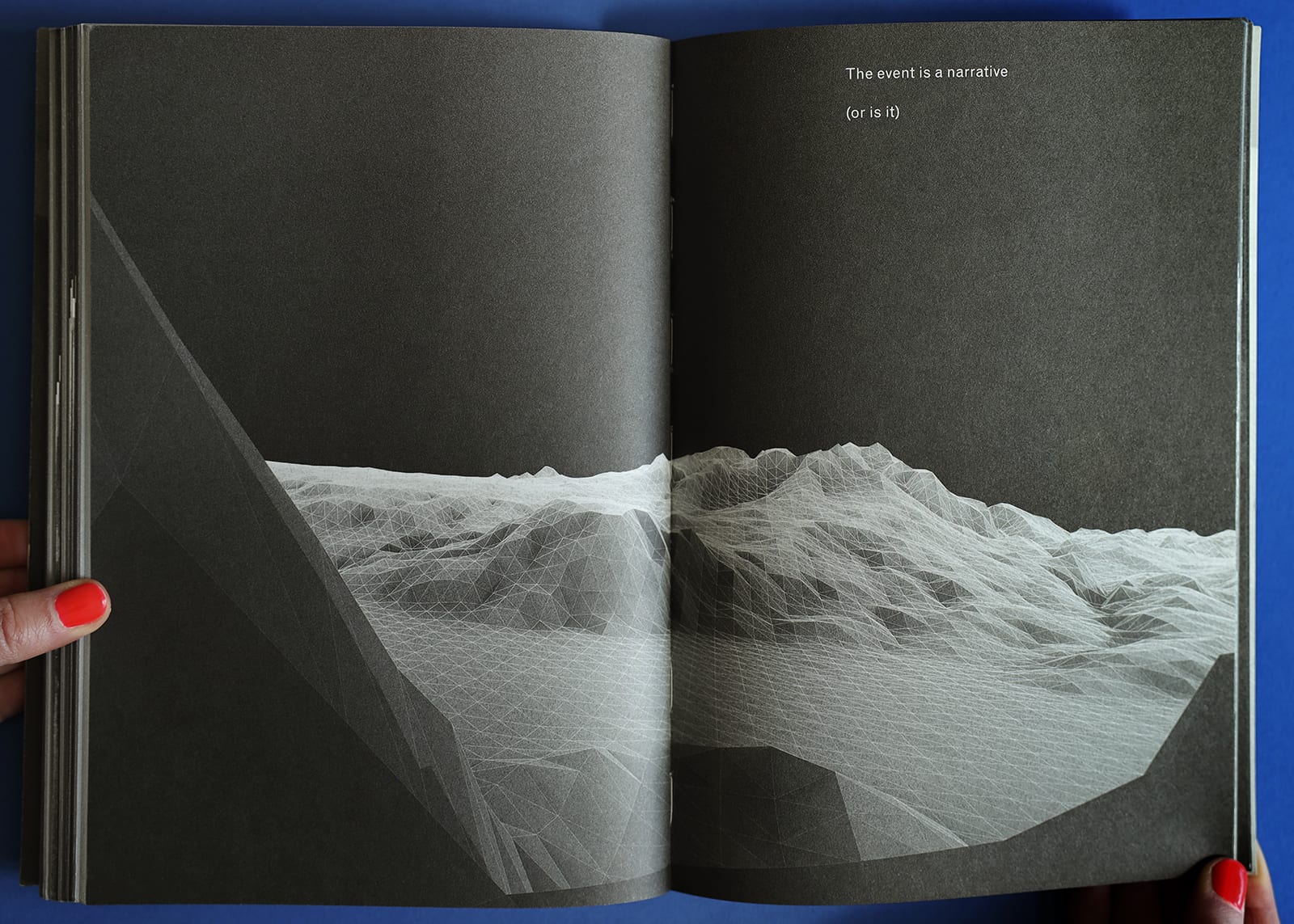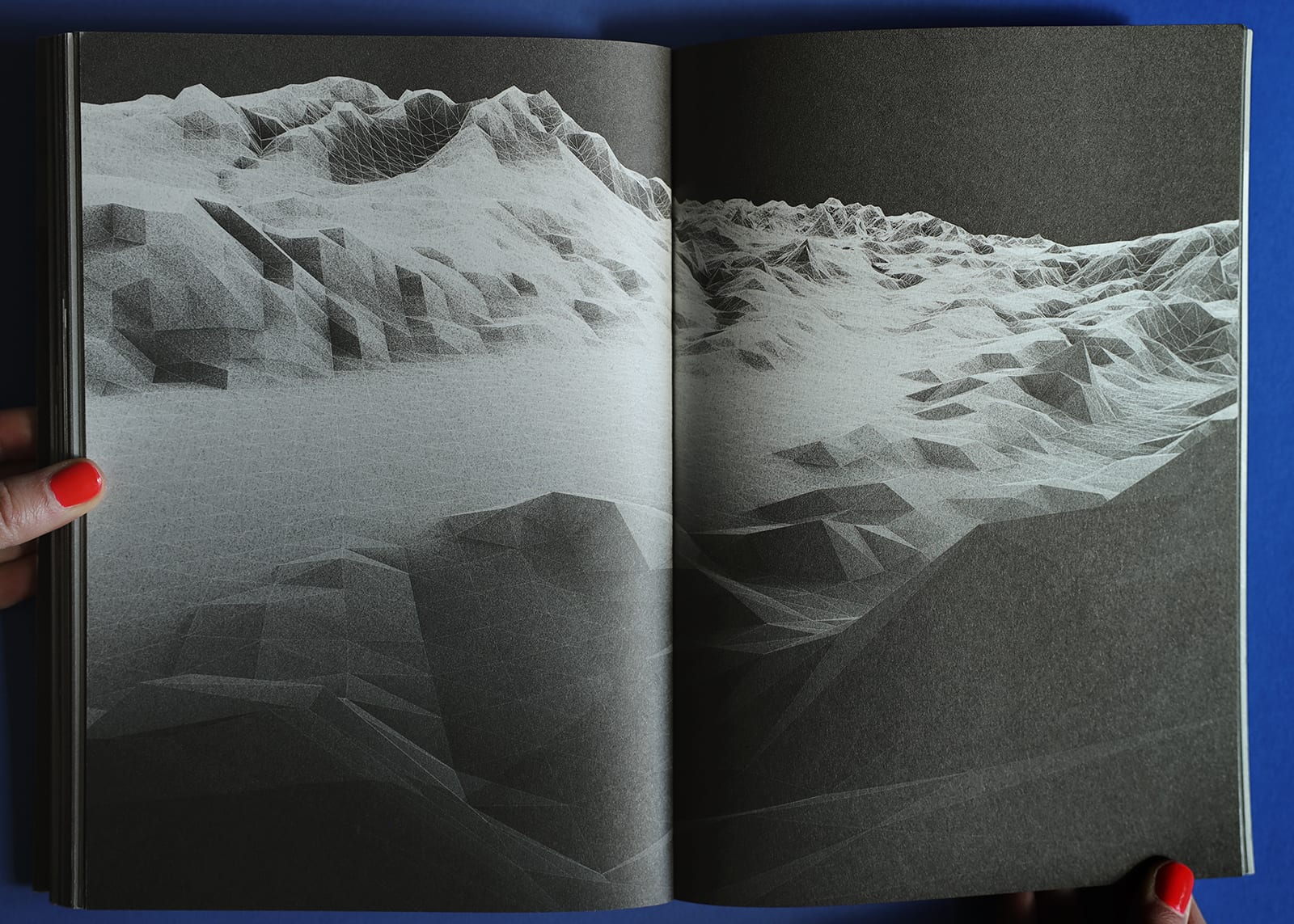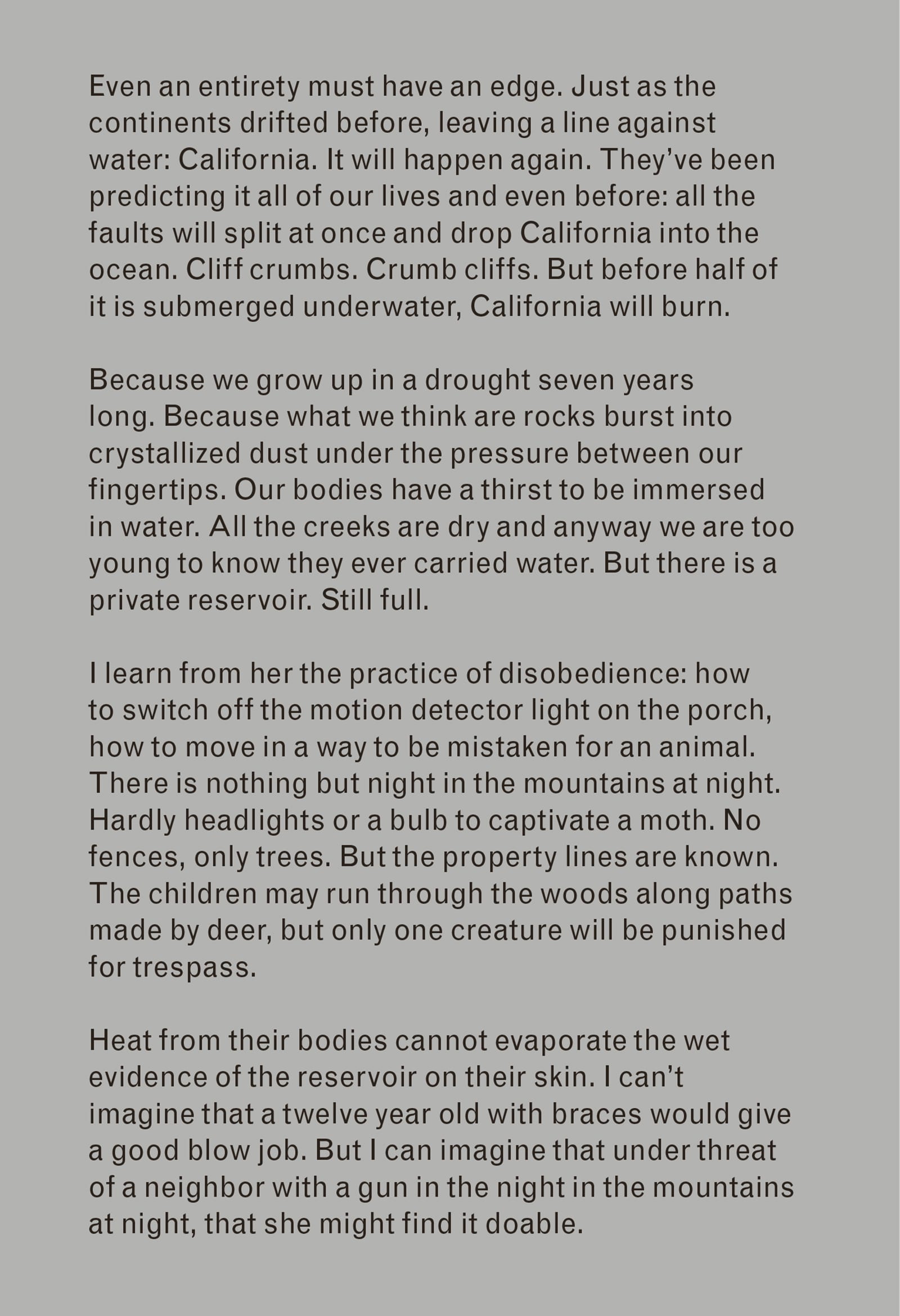Is there life after annihilation? Artist Caitlin Berrigan engages this question as a matter of necessity for geosocial existence and survival. The question also animates our mutual interests in deep time, the embodiments of fieldwork, and feminist approaches to technoscience. While the elemental zones through which we practice differ—I am a geographer who traces atmospheres and Caitlin follows the subterranean forces of rock and seismicity—our commitments to distributed networks of feeling and hybrid, technological forms of perception are resonant. Our work finds a common interface in the geohumanities, a discipline emerging from collaborations among geographers and artists.
We first met at Akademie Schloss Solitude in Stuttgart, Germany, where Caitlin held a fellowship and was working on her first book. Later, when we were thousands of kilometers apart, we spoke about art and geography in relation to Caitlin’s project Imaginary Explosions—a collection of episodic videos, sculptures, and texts that explores geologic histories, sexual violence, transfeminist coalitions, and expanded forms of sensing and signaling. In 2018–19, Caitlin was the recipient of a commission from the Royal Holloway Centre for the GeoHumanities, University of London, which supported a collaboration with volcanologist Karen Holmberg as well as a new video episode in the Imaginary Explosions series. In our discussion, we discover fault lines and fractures, mineral accretions and sedimentations of subjectivity, epistemology and geology.
—Sasha Engelmann

Caitlin Berrigan, Imaginary Explosions, 2018, artist’s book, 6 5/8 x 9 5/8 in. (17 x 24.5 cm), 208 pages, Berlin: Broken Dimanche Press (artwork © Caitlin Berrigan; design, Form und Konzept, Berlin; image data derived from the 2016 National Land Survey of Iceland; data processing, modeling, and rendering assistance, Lily Fang, John Fowler; photographs and animation provided by the artist). All following images © Caitlin Berrigan.
Caitlin Berrigan: Thank you for reading Imaginary Explosions.
Sasha Engelmann: It’s a feat. It was overwhelming. The matrices you weave in words, images, and moving images perform a kind of “geological sociality,” in the sense that one is impressed with the intimacies of flesh and rock, vulvas and volcanoes, blood and mineral. This is a sociality in the original sense of the Latin word socius, “to be allied, to be entangled with.”
In your studio, I saw your 3D visualizations and thought this book was going to be an experimental and diagrammatic work. I didn’t know you were also a poet and writer. These alliances of language and visual material were beautiful to encounter in these pages, especially because of the ways in which multiple temporalities of the geologic, the volcanic, and the human are expressed. Can you talk a bit about how you composed these materials in the book?
Berrigan: I wrote it over a few years. Short phrases started emerging, and I began writing them into gestural drawings. I was trying to find a language for latent catastrophes and violence, both social and environmental, and how we interpret and (mis)recognize their signs. A friend suggested, “Maybe this needs to be a book.” I began extending the written form into longer narrative poems. That felt on point. Then followed the technically complex and laborious process of producing all the topographical images, which are not illustrations but rather landscapes for the words. They are rendered using distant radar computations of the surface area of an active volcano in Iceland. I made a 3D model and moved through it to capture still frames with a virtual camera, placing sequential vistas from this path through the book, such that turning the pages is like walking through the volcanic landscape. It brings pauses between texts and dilations across light and dark gradients.
Engelmann: Yes. It doesn’t rest entirely on the description of matter’s fleshiness and the depiction of hot, earthy intimacies; it uses the trope of the volcanic explosion or the rocky avalanche as a grammatical gesture.
Your description of making the images for the book through a “virtual camera” immediately makes me think of the series of videos that are equally part of the Imaginary Explosions cosmology. You have produced two video episodes so far, which have invoked volcanic landscapes, ancient caves, and a cast of interconnected, multispecies characters with varying forms of artistic, technical, and scientific expertise—all to propose different modes of becoming geologic. And I feel that the book, as well as these video episodes,1 are probing and experimenting with the question of how to transpose myths of mineral, rock, and hot matter into timescales (or into forms of “present remoteness”) that are accessible by humans. In other words: How does one tell an ancient, “inhuman” story in the familiar terms of the present and the everyday?
Berrigan: One way that I have worked to do this is to explore the deep sense of time and temporality that links narrative episodes of geological ruptures with those of human trauma, and specifically with intergenerational narratives of sexual violence. Much like geological events, which are ongoing and latent and hardly given notice until they suddenly surge into human space and time (such as a volcanic eruption), intimate forms of sexual and domestic violence are similarly constant undercurrents in our lives. They are treated as isolated and personal events, despite the fact that we know that sexual violence is a pervasive, systemic social issue. Trauma from sexual violence reverberates across many different bodies through time and permeates our ways of interrelating. When I try to imagine the scales of sexual violence, I can only imagine the space required to hold the grief as taking on the magnitude of the whole planet. Time is a spatial experience, one that—like trauma—is in excess of the human body. This was the motivation to combine the spatial form of the codex with nonlinear and nonchronological texts to offer a somatic, time-based reading of violence and the fragmentation of subjectivity it provokes. The texts avoid narrating the events in favor of anticipation and aftermath.
Deep time is both the subject—as the geological narratives throughout the book—and also the concept at the root of “becoming mineral.” Both extend the idea that in our individual human shapes we exist alongside other forms and materialities of time that extend before, after, and through us. The idea of deep time embodiment and interdependence is in contrast to the logics of patriarchal violence, which calls itself into being as the exceptional power to exist outside of and master over others.
Engelmann: Some of the important work that your book does in relation to patriarchy is to frame it not as a relatively recent kind of anthropic and hubristic imprint on the earth—as the so-called Anthropocene is framed—but actually as a deeper force that is inscribed into landscapes that we find in the book.
In other words, it’s significant that you discuss patriarchy alongside deep time forces, and so we get this sense that human, social, and workplace issues of patriarchal violence are not surface phenomena. They are coursing and repeated: refrains of relationships that have been playing themselves out in relation to the earth for thousands of years.
There are some vivid moments in the book where annihilation occurs, and it is linked to the “becoming mineral,” as you just suggested. I wonder if you could speak a bit more about annihilation, and what does that mean in relation to minerality?
Berrigan: I want to acknowledge that people, things, and parts of ourselves can be destroyed and lost forever through annihilating acts of violence. An identification with the mineral comes from a desire to transform the fractured remains that survive annihilation into another shape—to subjectify dehumanized matter. We who are subjected to violence, or who are in relation to a lost subject of violence, we are becoming mineral as part of a metanarrative of collective transformation, in the sense that we are particles of shared materiality. On the other hand, it is important to acknowledge that there is a point of no return from many acts of violence, extinction, elimination, and annihilation. We need shared spaces to hold the collective grief of loss. Physical death is only one such loss. In this way, I want to underline that acts of violence cannot be dismissed. We lack spaces for acknowledgment, grief, repair, and reparation.
Sexual violence is a part of the architecture of patriarchy, one that upholds the centralizing axis of power around proximity to the figural myth of the white, cisgender, heterosexual man. With differing degrees of vulnerability, individuals of all ages and genders are subject to such extraordinary amounts of sexual violence committed almost entirely by cis men, even when aided by others. This is an immense social issue of asymmetrical power. Although Tarana Burke’s original formulation of the #MeToo movement was based in the solidarity and empowerment of a broad range of sexual assault victims, the emergence of #MeToo in the media sphere has thus far focused on high-profile cases of men in positions of power in the workplace, schools, and professions. I hope that domestic and intimate violence will also rise into the collective dialogue and no longer be relegated to private spheres of personal responsibility and shame. The transformative justice work of people like Mariame Kaba, who bring together intimate violence with abolition movements, is an inspiration. I want to contribute to naming sexual and domestic violence as forms of structural violence.
Engelmann: I was struck by the passage in which the narrator’s partner threatens her, and there’s this anticipation of physical pain. Then a scene follows in a flagship cosmetics store where “the Central Park West teenage girls are dusting / their flawless eyelids” with eyeshadow “composed of minerals and crushed insect wings,” and they have this palpable glow around them. Yet as we encounter this glowing image we are still feeling the undercurrent of the threat that had just occurred, and we are aware of its enduring pain. We are aware of the possibility of annihilation.
There are other scenes that experiment with multiple senses of space: scenes of going out in a boat on a cold lake, scenes of seeing architecture in the city. They feel to me like snow globes, capsules of vivid scenography. Yet there are also these horizons, landscapes, and panoramas of rock, mineral, energy, and coursing lava. I wonder, first, how you construct spaces for the geographies of everyday life, like those of the cosmetics store, and second, how you work these capsules into the book’s larger panoramas?
Berrigan: It’s nice to hear you describe the scenes as snow globes, because it conveys something contained. It also makes them shatterable and explosive. Each scene has its own landscape, and trauma can keep you trapped inside that snow globe of an event space. This dense memory site never quite changes its hard and troubled little world.
Engelmann: It’s also not unlike how searing away a rock face exposes pores of dense minerality and pigmentation with a certain intensity to them; yet they’re embedded in these larger sedimentations and much larger morphologies.
Berrigan: Yes, and holding these individually vivid and precise scenes within a nonchronological, expansive space of the book was an attempt to create for the reader a feeling of moving in and out of how the integrity of a “self” is shattered both by personal trauma and also by the haunting legacies of the traumas of others. Subjectivity is blown apart by trauma; meaning and making sense of oneself are scattered. I wanted to do this in the timing and spatialization of texts. I wrote the book not as a collection, but as parts to be sequenced together in a way that they interact with each other as a whole. This was the intention behind having a narrator whose movements across the globe and through time make little narrative sense but that build into a rhythmic sequencing. It is moving toward the notion that our embodied experience is living across not just our own memories but also those of others. It is being multiple and living across a multiplicity of events from past, present, and future.
Engelmann: After reading the book and engaging with your video episodes, I’m fascinated not only by the way you evoke minerals and horizons, speeds, and slownesses but also by how your own fieldwork moves into words, images, and stories. You just came back from a trip to a volcanic site in Chile, and I am curious what trips like this mean for your practice, and which moments from your other visits to geological formations and volcanic regions continually permeate through your work?
Berrigan: In your work on atmospheres and eavesdropping on weather satellites in the project open-weather, which includes performances like the Satellite Séances, I appreciate the importance of being in the field for practicing research as a form of creative observation. It’s about being receptive to uncertainty, and being changed by what is alien to you. It requires being present in an embodied, observational mode for discoveries and interrelations to manifest. When I teach undergraduates to work with moving images and video, I want them to learn how to see and observe the world and create new images with their unique, embodied selves. Because in the act of observing the world, there’s a cycle of being affected and transformed by it and seeing it again through the images created from it. Writing does this too: seeing the world again through language. It is a necessary practice of going up close and positioning ourselves adjacent and in relation to people and places, rather than relying on a theoretical or secondhand engagement with them.
I used to love assigning found footage exercises with students: having them make montages from other people’s material they find. But I have seen, more and more, that my students don’t want to film each other in their own scripts, or try any other kind of filmmaking, but prefer to go online, search for, and edit other people’s footage. This is its own legitimate aesthetic, creative, and conceptual process, and it is just as time-consuming as shooting your own material and cutting it, but what I fear is that they don’t give energy to on-site, embodied observation and sensing. That process does not entail a situated effort to live outside of filters, out in the world, viewing it, self-reflecting, and then transmitting something new from their formulations.
I had a nightmare in the midst of teaching that we as a culture had collectively forgotten how to observe the world. No new images were being created. Only constantly recycled images existed, that had been captured previously by others from another time. To go back to your question, it is in this sense that the field is a site of opportunity for dialectical transformation, new observations, and reconfigurations. It’s a place for my assumptions to be challenged and in which to make connections across artists, scientists, and researchers and to have encounters with other people and beings.
Engelmann: In my view, part of what you bring into your fieldwork is a playfulness and a willingness to experiment with the stories that are told about landscapes. You visit volcanic sites, and you visit sites that have witnessed extreme extractive processes. Yet I was struck, in episode 1 of the Imaginary Explosions video series, by the scene of you bounding over the lava rocks to listen to a solar-powered GPS station array perched there like a strange insect. And, of course, echoing and shimmering throughout the Imaginary Explosions book are myriad tropes and images of the volcano, whether we’re looking down at the volcano, into the eye or the core, or whether we’re approaching from a distance. In that gesture of the approach, we feel a movement and a landscape that’s also a site of precarity as well as precarious possibility.
In other scenes in the book we encounter rock bridges and ledges that have been standing for hundreds of years but may collapse at any moment. There is a sense of the field moving through the text, something that animates the relationship between the body of research and fieldwork and the body of the artist or character. I wonder if you could speak about the sense of precarity or precarious possibility that is so palpable in your work, and also your fascination with eruptions.
Berrigan: They are all active volcanic sites, which serve our imaginations. Around subjects of rupture and collapse, there is again this question of transformation, and how do we live on after annihilation? Geological change is not necessarily gradual but can be sudden and violent, with a pattern of ongoing, punctuated events.
The same can be said for extractive economies, many of which can be found around active volcanic sites, as tectonic processes produce many resources that are of great value to industrialized society. Intensive extractive projects, such as geothermal heat and deep-sea mineral mining, assume that we know enough of the risks to prospect—not to mention that there is collective consent to do so. Yet industrialized capitalist societies fail to acknowledge and correct the asymmetry of precarity. The subsidies for cheap energy and resources are ultimately paid for by the most dispossessed among us—in most cases people of color, women, and nonhuman entities such as animals, mountains, and rivers. This is not to say that we should never undertake large-scale technologies. It’s to say that the stakes are more about abuses of power than they are about technological achievement.
Engelmann: I think that’s an apt way to frame extraction: via “abuses of power” in relation to large-scale technologies. Could you expand on that a bit? Especially in relation to the questions of sexual violence with which we began?
Berrigan: Sexual violence is ultimately about power, not sexuality. It is one manifestation of disciplining violence, which is enacted by forces that uphold the patriarchal ordering of the world. While the abuses of power that you are asking about cannot be conflated or confused with each other, sexual violence and extractive economies are within the same logic of possession and power. The technologies behind extractive processes are themselves not the culprits, but rather they are instruments in the patriarchal logics of violence enacted upon subjects that may include entire communities, ecologies, and species.
Engelmann: I agree. In light of this, the speculative project of both the Imaginary Explosions book and the video episodes becomes one way of undoing patriarchy at the structural and geological level. It is a project of identifying the complicity between patriarchy and power at the scale of the landscape, the site of extraction and of the planet, too. The work of undoing the vast infrastructures of patriarchy at these geological sites and scales is thus about finding pores and gaps, fault lines and pressure points, subsurface energies and flows that refuse the modes of thinking, subjecting, and extracting that are unanimous with patriarchy. Your video episodes do this by evolving a set of relationships between humans, nonhuman species, earth minerals, and volcanoes.
Berrigan: Yes, exactly. The videos are ongoing and episodic, but what I want to think about is how to examine these power structures and undo the hold of patriarchy not through strongly individualized, heroic narratives but rather through collective ones. The individual characters align with the mineral, and as they appear and disappear, we will be somewhat unattached to them as individuals, but the videos try to show network and collectivity through deep time.
Engelmann: This raises the question of how the book and your video work respond to each other. They build on each other, but each does different things in relation to the narratives you are constructing. Your videos work around an unfolding narrative that has to do with a group of transfeminists who conspire with all of earth’s volcanoes to erupt simultaneously. The characters invent a series of mechanisms to do so, but they also have ways of monitoring volcanic activity through seismic sensors and radio receivers, among other technologies.
What I see more clearly happening in the book are gestures of self-transformation and efforts of dealing with the personal and intimate histories that are always enfolded in earth histories. In contrast, the videos are more suggestive of what you were just speaking about: how might we imagine becoming other, becoming mineral, or becoming sensitive to the earth in ways that are more playful and involve new coalitions, gatherings, and alliances that enable us to experiment with ideas of earth history, identity, and subjectivity?
Berrigan: You’re right. The videos are still works in progress, and the book has extended into their production. Texts from the book infuse narration and dialogue in the videos, and the synthetic landscapes have been made into video animations and deployed in installations. While the book is distributable, it is nonetheless a time-based medium made for a solitary reader, with a written first-person narrator speaking from the page. The video episodes are more about shaping and representing collective affiliation and transformation on the screen by bringing in other people and characters.
Engelmann: I think that comes through in episode 1 of the video series, in which there’s a query around why the Eyjafjallajökull volcano has erupted at this time. It’s a mystery. It has not been the decision of the transfeminist network, or even of one member within it, to conspire with the eruption. It is rather an expression of a build-up of inhuman force that has been simmering invisibly for some time. The characters in the film are asking each other questions about the impetus for that eruption.
This idea of becoming mineral and becoming attuned to the mineral is striking for me. It is a paratechnological achievement, like an extension of the senses. The paratechnological matrix of sensors in episode 1 of the Imaginary Explosions video series is a feeling network for bodies—primarily female, nonbinary, and trans bodies—that are attempting to tune to and attune with the Earth.
Berrigan: I love the way you describe it. This returns to the importance of embodied field research. Many of the technologies and infrastructures that have been part of the destructive military and industrial processes must be seized and made to work toward our own alternative purposes. It is about a transition of power. We are already transformed by these technologies. How can we inhabit them differently? But I am not just interested in the knowledge produced through technology and technological embodiment: it’s the power dynamics of how that knowledge is formulated, received, and then how it is communicated and deployed in the world. These are the forms of patriarchy that have to be considered at all levels.
The inhabitation of technologies through transfeminist power dynamics and embodiment is critical. I am aiming toward a more speculative and propositional mode of being, because we are not there yet. Not being a scientist myself, and yet laying claim to participating in and being changed by scientific knowledge production, I engage with technoscience according to an outsider’s methodology. At the same time, culture is always already embedded within the epistemologies of scientific knowledge. I would like the video episodes to be evocative of methods of knowledge production that can undo the patriarchal hold on technoscientific systems.
Engelmann: I was just going to add that it’s very beautiful that we can even have this conversation. You just said you are not a scientist. However, you also are quite like a scientist, and you are quite like a geographer in much of the work that you do. And I am a geographer, but I do not sit comfortably in the social or natural sciences. I also stray. Our conversation today is a lens that refracts some of the emancipatory and hopeful possibilities that you were just referring to, the kinds of alliances that can form among transfeminists and across disciplines. And I hope that we can remain on this plane of resonance together.
Berrigan: Yes, me too. There is a politics to not ever resting comfortably in one’s positions.
Caitlin Berrigan works across video, sculpture, performance, and text. Imaginary Explosions was the subject of a solo show at Art in General in New York (2019), an international premiere at the Berlinale Forum Expanded, Berlin (2020), and an artist’s book with Broken Dimanche Press, Berlin (2018). She is an artist, writer, and researcher affiliated with the PhD in Practice program at the Academy of Fine Arts in Vienna and the Department of Technology, Culture, and Society, New York University Tandon School of Engineering.
Sasha Engelmann is a feminist geographer investigating creative modes of environmental sensing. She is lecturer in GeoHumanities at Royal Holloway, University of London, where she codirects the GeoHumanities Creative Commissions program. With Sophie Dyer she leads the feminist satellite decoding project open-weather. Her new book is Sensing Art in the Atmosphere: Elemental Lures and Aerosolar Practices (Routledge, 2020).
- Caitlin Berrigan, Imaginary Explosions, Episode 1, Eyjafjallajökull (2018); trailer, Imaginary Explosions, Episode 2, Chaitén (2019); Becoming Mineral (2018). ↩



